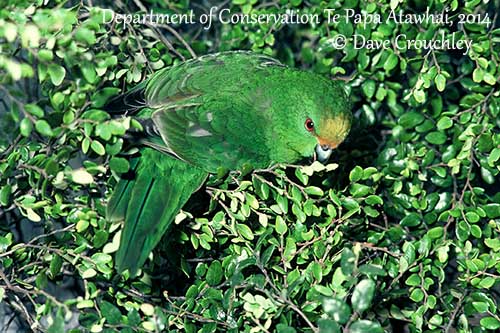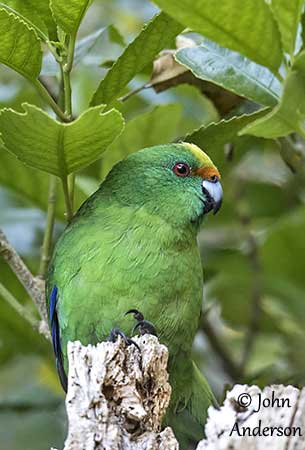
REPRODUCTION OF THIS SPECIES:
The Malherbe’s Parakeet can breed in all months, with a peak between December and April. When there are abundant food resources, they can breed for 18 months without a break.
The nest is placed inside a cavity or a hollow high in beech tree.
The female lays 5-8 white eggs. The incubation lasts 21-26 days, and is performed by the female which also broods the chicks. The male provides most of food during the period. The chicks are fed mainly with beech seeds and invertebrates. The female feeds them during the first two weeks, and then, both adults feed them. The juveniles fledge 35-45 days after hatching.
PROTECTION / THREATS / STATUS:
The Malherbe’s Parakeet is threatened by introduced rats and stoats, but changes in the habitat due to deer and possums also affect this species. Some diseases have been discovered in two areas.
Conservation actions such as control of predators within the three mainland valleys and protection of the nesting trees are under way.
Captive breeding programs allow releasing birds onto four predator-free islands. This work is on-going.
On the mainland, all the populations are closely monitored by the Department of Conservation.
The global population has been estimated at 290/690 individuals in early 2013: mainland population = 130/270 individuals - island populations = 160/420 individuals.
The Malherbe’s Parakeet is listed as Critically Endangered in spite of the slow increase of the numbers with successful translocations.
Fr: Perruche de Malherbe
Maori: kākāriki karaka
Ang: Malherbe's Parakeet
All: Malherbesittich
Esp: Perico Maorí Montano
Ita: Parrocchetto di Malherbe
Nd: Oranjevoorhoofdkarakiri
Sd: Orangepannad parakit
Photographers:
John Anderson
John Anderson Photo Galleries
Dave Crouchley
Courtesy of Department of Conservation Te Papa Atawhai, 2014
Department of Conservation
Title: Orange fronted Parakeet
Photographer: Crouchley, Dave
Date: 1983
Location: Nelson-Marlborough Conservancy
Description: Orange fronted Parakeet, Nelson, January 1983
Text by Nicole Bouglouan
Sources:
PARROTS OF THE WORLD – An Identification Guide – by Joseph M. Forshaw – Princeton University Press – ISBN 0691092516
BirdLife International (BirdLife International)
New Zealand bird status between 2008 and 2012
Malherbe’s Parakeet
Cyanoramphus malherbi
Psittaciformes Order – Psittaculidae Family
INTRODUCTION:
The Malherbe’s Parakeet is the rarest parakeet of New Zealand. The population of this species has been predated by introduced rats and stoats. It is the smallest member of the genus Cyanoramphus, and is very similar to the Yellow-fronted Parakeet (C. auriceps).
DESCRIPTION OF THE BIRD:
Biometrics:
Length: 19-22 cm
Weight: M: 40-52 g – F: 30-41 g
The adult has green plumage overall, with blue-green wash on the underparts. The upperwing shows violet-blue outer webs of flight feathers. The long graduated tail is green. There is an orange patch on each side of the rump.
On the head, there is an orange frontal band, slightly paler towards the eye, while the forecrown is pale yellow.
The bill is silvery-grey, with dark tip. The eyes are orange-red. Legs and feet are brown.

Title: Orange fronted Parakeet
Photographer: Crouchley, Dave
Date: 1983
Department of Conservation Te Papa Atawhai, 2014
Both sexes are similar, with male larger than female.
The juvenile resembles adults, but the frontal band is paler and indistinct. The eyes are pale brown. The tail is shorter.
RANGE:
The Malherbe’s Parakeet is found in the South Island, and is restricted to the beech forests within Arthur’s Pass National Park and Lake Sumner Forest Park in Canterbury.
HABITAT:
The Malherbe’s Parakeet frequents the beech forests of upland valleys in the South Island, and occurs from valley floor to alpine areas.
CALLS AND SONGS:
The Malherbe’s Parakeet utters a loud chatter of variable length and intensity. Both mates communicate with softer sounds such as chatter, churr and squeak. The courtship call is a single squeak.
BEHAVIOUR IN THE WILD:
The Malherbe’s Parakeet feeds on a large variety of plant matter including seeds, buds, shoots, flowers, leaves, ferns and grasses. During spring, it also feeds on numerous invertebrates such as insects (Hemiptera) and caterpillars.
This species forages usually high in trees, but also in the low vegetation and on the ground, according to the food items.
During the breeding season, the female chooses the nest-site and performs most of the nesting duties, while the male provides food.
This species is a cavity-nester like numerous Psittaciformes. They can breed in all months if there are abundant food resources.
There is no information about movements during the year, and the species is probably sedentary.
The flight is fast and undulating.
